Comprehensive Analysis of Woolworths' Retail Management Strategies
VerifiedAdded on 2020/03/16
|8
|1947
|29
Report
AI Summary
This report provides an in-depth analysis of Woolworths' retail management strategies. It examines the company's product offerings, which include a wide variety of grocery items, stationary, DVDs, and magazines, with a focus on customer satisfaction and product quality. The report explores Woolworths' pricing strategies, including its efforts to maintain competitive prices and its use of loyalty programs and shopping cards. It also investigates the company's promotional activities, such as loyalty schemes and social media marketing, and its store locations, including its online presence and mobile app. Furthermore, the report discusses Woolworths' customer service approach, emphasizing customer loyalty and satisfaction, along with the company's store layout and design, focusing on space, lighting, and security features. The analysis highlights how Woolworths aims to meet consumer needs and maintain a strong market presence through various strategies. This report provides a comprehensive overview of Woolworths' marketing mix, customer service, and overall approach to retail management.
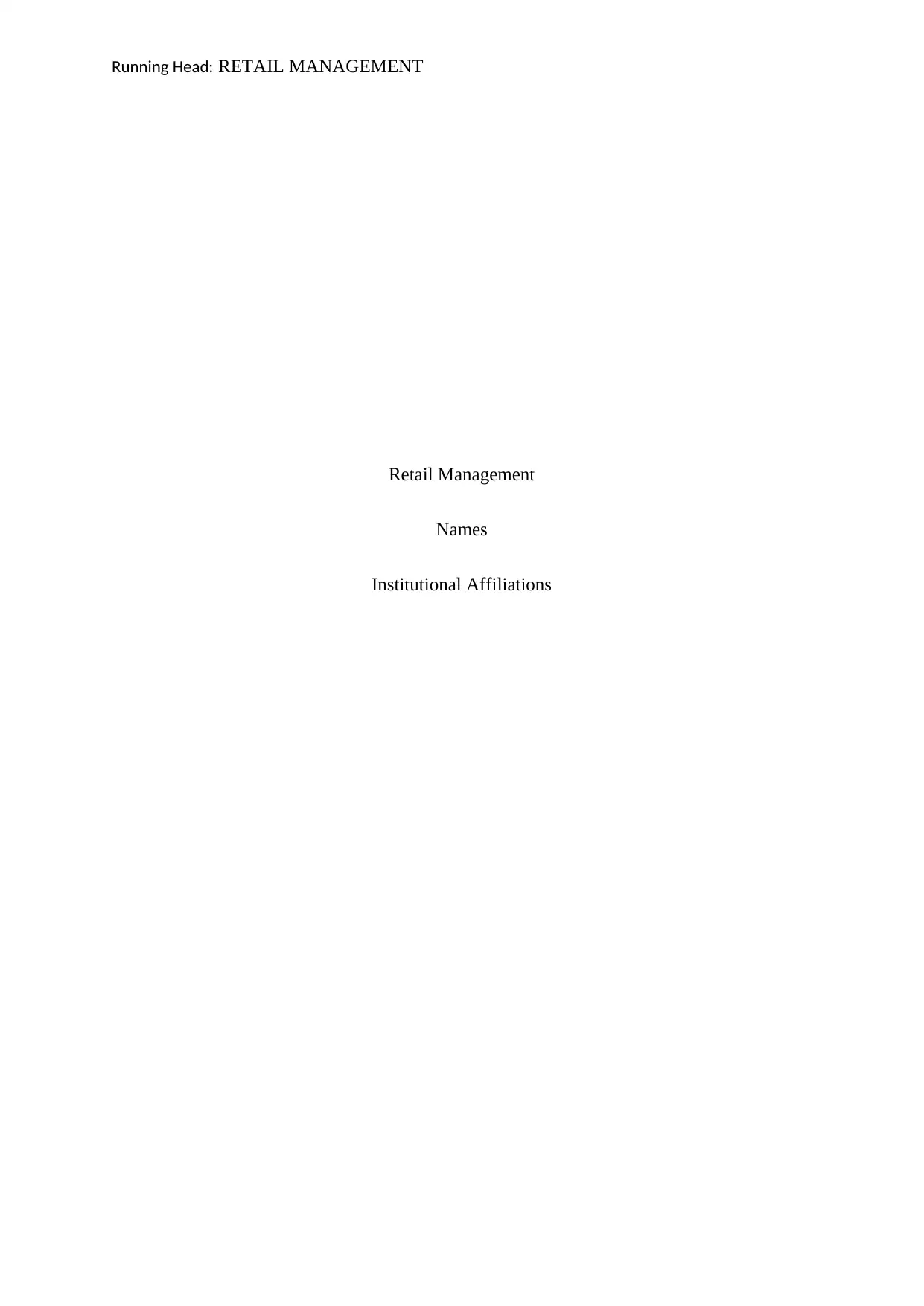
Running Head: RETAIL MANAGEMENT
Retail Management
Names
Institutional Affiliations
Retail Management
Names
Institutional Affiliations
Paraphrase This Document
Need a fresh take? Get an instant paraphrase of this document with our AI Paraphraser
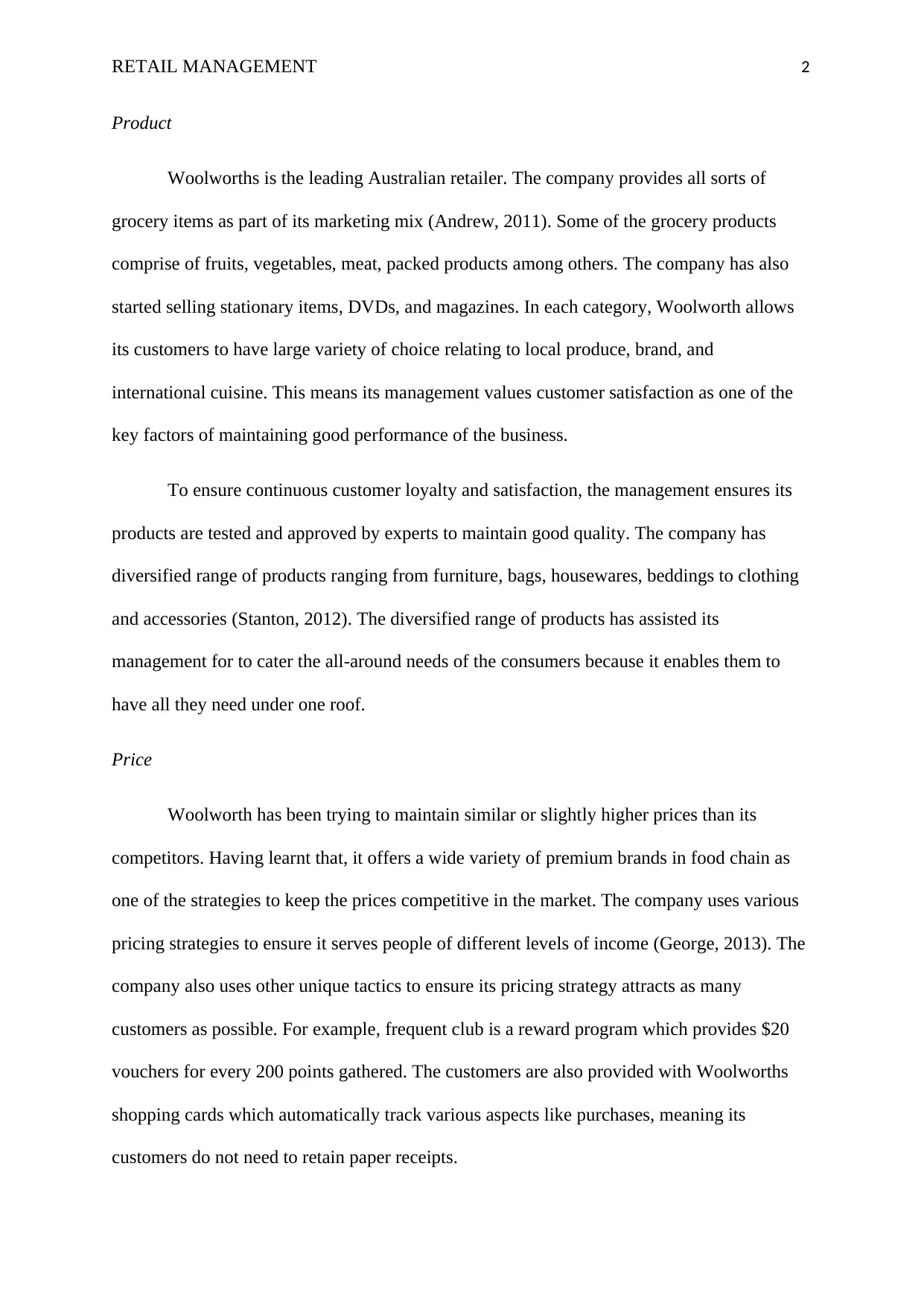
RETAIL MANAGEMENT 2
Product
Woolworths is the leading Australian retailer. The company provides all sorts of
grocery items as part of its marketing mix (Andrew, 2011). Some of the grocery products
comprise of fruits, vegetables, meat, packed products among others. The company has also
started selling stationary items, DVDs, and magazines. In each category, Woolworth allows
its customers to have large variety of choice relating to local produce, brand, and
international cuisine. This means its management values customer satisfaction as one of the
key factors of maintaining good performance of the business.
To ensure continuous customer loyalty and satisfaction, the management ensures its
products are tested and approved by experts to maintain good quality. The company has
diversified range of products ranging from furniture, bags, housewares, beddings to clothing
and accessories (Stanton, 2012). The diversified range of products has assisted its
management for to cater the all-around needs of the consumers because it enables them to
have all they need under one roof.
Price
Woolworth has been trying to maintain similar or slightly higher prices than its
competitors. Having learnt that, it offers a wide variety of premium brands in food chain as
one of the strategies to keep the prices competitive in the market. The company uses various
pricing strategies to ensure it serves people of different levels of income (George, 2013). The
company also uses other unique tactics to ensure its pricing strategy attracts as many
customers as possible. For example, frequent club is a reward program which provides $20
vouchers for every 200 points gathered. The customers are also provided with Woolworths
shopping cards which automatically track various aspects like purchases, meaning its
customers do not need to retain paper receipts.
Product
Woolworths is the leading Australian retailer. The company provides all sorts of
grocery items as part of its marketing mix (Andrew, 2011). Some of the grocery products
comprise of fruits, vegetables, meat, packed products among others. The company has also
started selling stationary items, DVDs, and magazines. In each category, Woolworth allows
its customers to have large variety of choice relating to local produce, brand, and
international cuisine. This means its management values customer satisfaction as one of the
key factors of maintaining good performance of the business.
To ensure continuous customer loyalty and satisfaction, the management ensures its
products are tested and approved by experts to maintain good quality. The company has
diversified range of products ranging from furniture, bags, housewares, beddings to clothing
and accessories (Stanton, 2012). The diversified range of products has assisted its
management for to cater the all-around needs of the consumers because it enables them to
have all they need under one roof.
Price
Woolworth has been trying to maintain similar or slightly higher prices than its
competitors. Having learnt that, it offers a wide variety of premium brands in food chain as
one of the strategies to keep the prices competitive in the market. The company uses various
pricing strategies to ensure it serves people of different levels of income (George, 2013). The
company also uses other unique tactics to ensure its pricing strategy attracts as many
customers as possible. For example, frequent club is a reward program which provides $20
vouchers for every 200 points gathered. The customers are also provided with Woolworths
shopping cards which automatically track various aspects like purchases, meaning its
customers do not need to retain paper receipts.
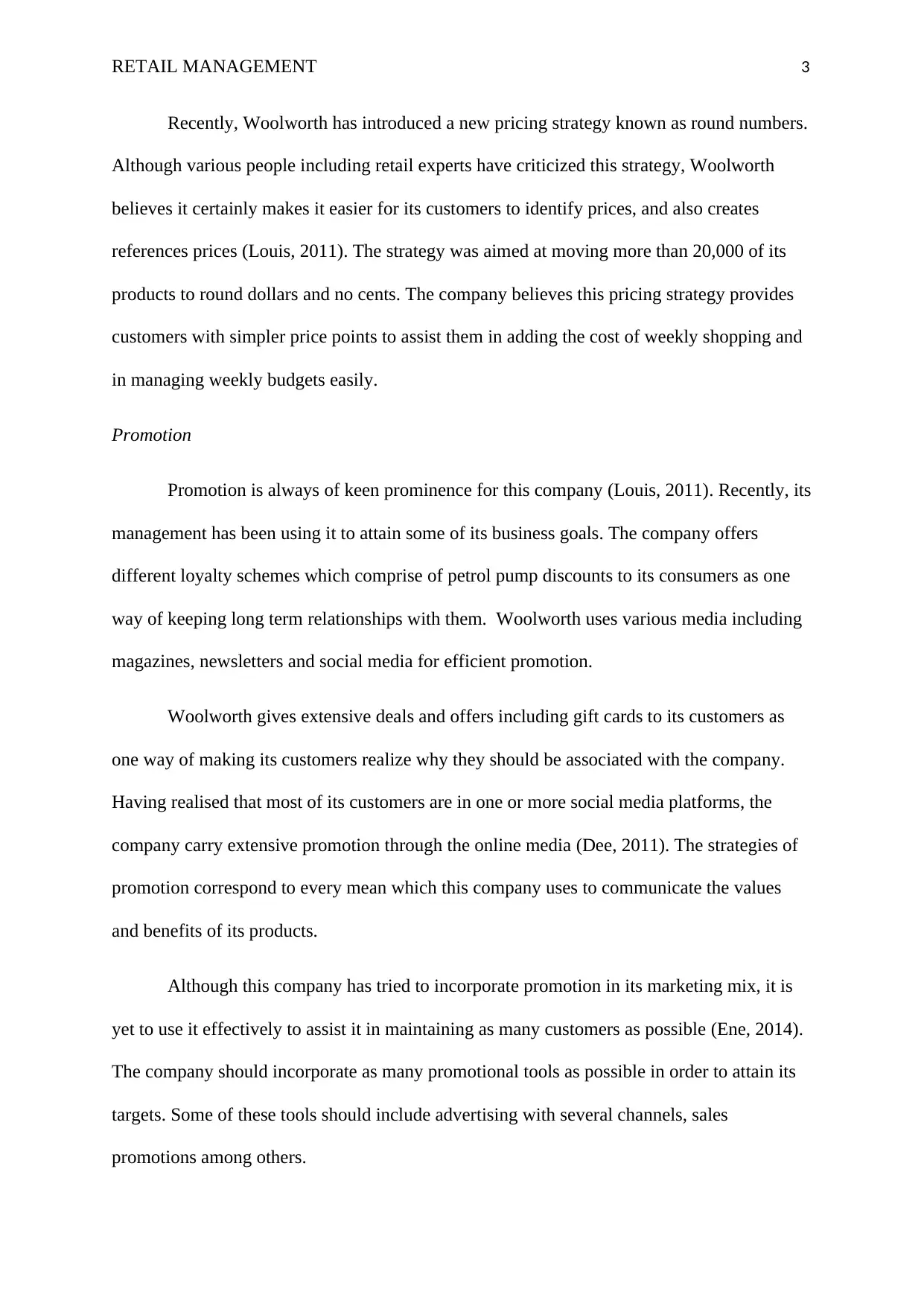
RETAIL MANAGEMENT 3
Recently, Woolworth has introduced a new pricing strategy known as round numbers.
Although various people including retail experts have criticized this strategy, Woolworth
believes it certainly makes it easier for its customers to identify prices, and also creates
references prices (Louis, 2011). The strategy was aimed at moving more than 20,000 of its
products to round dollars and no cents. The company believes this pricing strategy provides
customers with simpler price points to assist them in adding the cost of weekly shopping and
in managing weekly budgets easily.
Promotion
Promotion is always of keen prominence for this company (Louis, 2011). Recently, its
management has been using it to attain some of its business goals. The company offers
different loyalty schemes which comprise of petrol pump discounts to its consumers as one
way of keeping long term relationships with them. Woolworth uses various media including
magazines, newsletters and social media for efficient promotion.
Woolworth gives extensive deals and offers including gift cards to its customers as
one way of making its customers realize why they should be associated with the company.
Having realised that most of its customers are in one or more social media platforms, the
company carry extensive promotion through the online media (Dee, 2011). The strategies of
promotion correspond to every mean which this company uses to communicate the values
and benefits of its products.
Although this company has tried to incorporate promotion in its marketing mix, it is
yet to use it effectively to assist it in maintaining as many customers as possible (Ene, 2014).
The company should incorporate as many promotional tools as possible in order to attain its
targets. Some of these tools should include advertising with several channels, sales
promotions among others.
Recently, Woolworth has introduced a new pricing strategy known as round numbers.
Although various people including retail experts have criticized this strategy, Woolworth
believes it certainly makes it easier for its customers to identify prices, and also creates
references prices (Louis, 2011). The strategy was aimed at moving more than 20,000 of its
products to round dollars and no cents. The company believes this pricing strategy provides
customers with simpler price points to assist them in adding the cost of weekly shopping and
in managing weekly budgets easily.
Promotion
Promotion is always of keen prominence for this company (Louis, 2011). Recently, its
management has been using it to attain some of its business goals. The company offers
different loyalty schemes which comprise of petrol pump discounts to its consumers as one
way of keeping long term relationships with them. Woolworth uses various media including
magazines, newsletters and social media for efficient promotion.
Woolworth gives extensive deals and offers including gift cards to its customers as
one way of making its customers realize why they should be associated with the company.
Having realised that most of its customers are in one or more social media platforms, the
company carry extensive promotion through the online media (Dee, 2011). The strategies of
promotion correspond to every mean which this company uses to communicate the values
and benefits of its products.
Although this company has tried to incorporate promotion in its marketing mix, it is
yet to use it effectively to assist it in maintaining as many customers as possible (Ene, 2014).
The company should incorporate as many promotional tools as possible in order to attain its
targets. Some of these tools should include advertising with several channels, sales
promotions among others.
⊘ This is a preview!⊘
Do you want full access?
Subscribe today to unlock all pages.

Trusted by 1+ million students worldwide
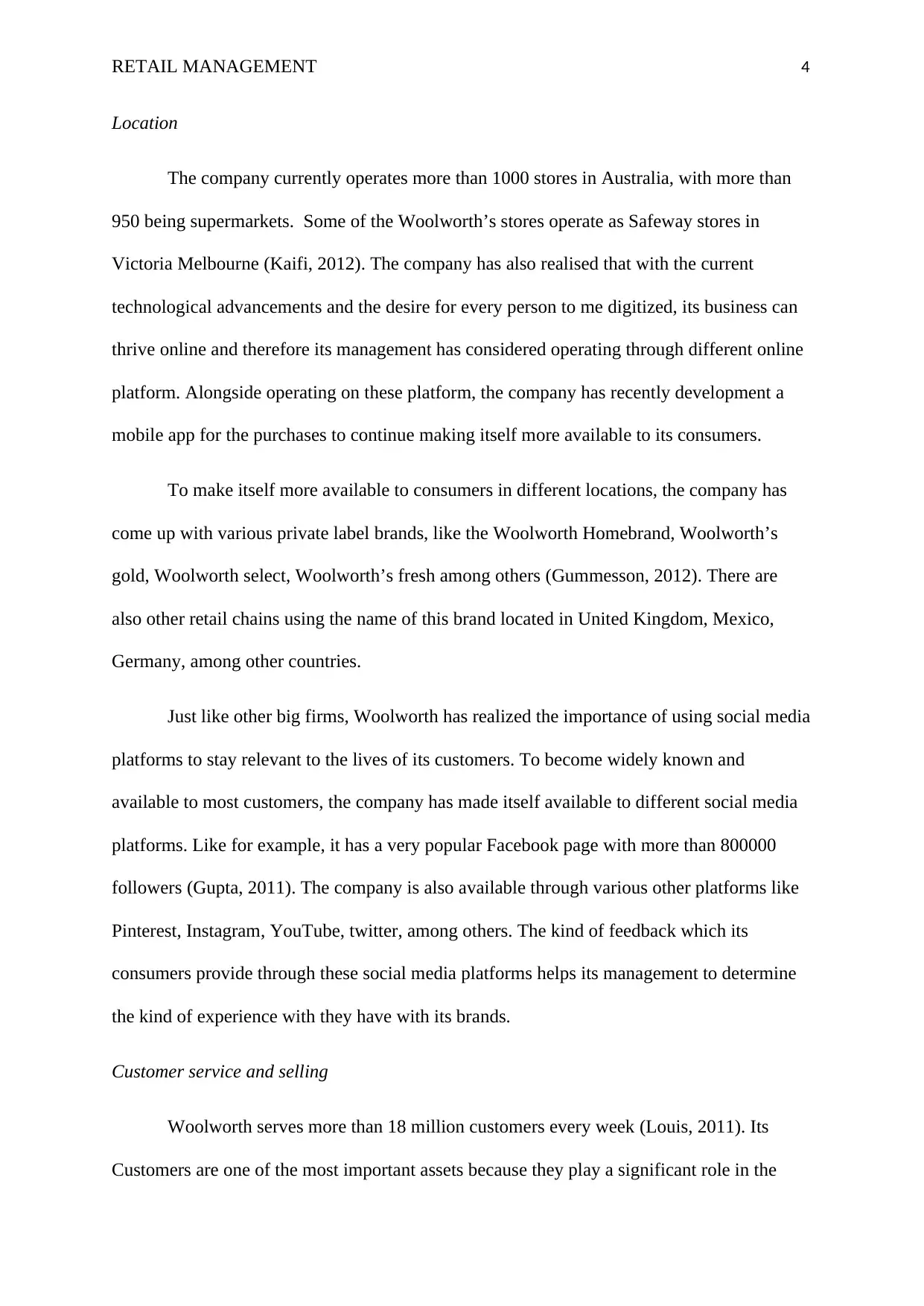
RETAIL MANAGEMENT 4
Location
The company currently operates more than 1000 stores in Australia, with more than
950 being supermarkets. Some of the Woolworth’s stores operate as Safeway stores in
Victoria Melbourne (Kaifi, 2012). The company has also realised that with the current
technological advancements and the desire for every person to me digitized, its business can
thrive online and therefore its management has considered operating through different online
platform. Alongside operating on these platform, the company has recently development a
mobile app for the purchases to continue making itself more available to its consumers.
To make itself more available to consumers in different locations, the company has
come up with various private label brands, like the Woolworth Homebrand, Woolworth’s
gold, Woolworth select, Woolworth’s fresh among others (Gummesson, 2012). There are
also other retail chains using the name of this brand located in United Kingdom, Mexico,
Germany, among other countries.
Just like other big firms, Woolworth has realized the importance of using social media
platforms to stay relevant to the lives of its customers. To become widely known and
available to most customers, the company has made itself available to different social media
platforms. Like for example, it has a very popular Facebook page with more than 800000
followers (Gupta, 2011). The company is also available through various other platforms like
Pinterest, Instagram, YouTube, twitter, among others. The kind of feedback which its
consumers provide through these social media platforms helps its management to determine
the kind of experience with they have with its brands.
Customer service and selling
Woolworth serves more than 18 million customers every week (Louis, 2011). Its
Customers are one of the most important assets because they play a significant role in the
Location
The company currently operates more than 1000 stores in Australia, with more than
950 being supermarkets. Some of the Woolworth’s stores operate as Safeway stores in
Victoria Melbourne (Kaifi, 2012). The company has also realised that with the current
technological advancements and the desire for every person to me digitized, its business can
thrive online and therefore its management has considered operating through different online
platform. Alongside operating on these platform, the company has recently development a
mobile app for the purchases to continue making itself more available to its consumers.
To make itself more available to consumers in different locations, the company has
come up with various private label brands, like the Woolworth Homebrand, Woolworth’s
gold, Woolworth select, Woolworth’s fresh among others (Gummesson, 2012). There are
also other retail chains using the name of this brand located in United Kingdom, Mexico,
Germany, among other countries.
Just like other big firms, Woolworth has realized the importance of using social media
platforms to stay relevant to the lives of its customers. To become widely known and
available to most customers, the company has made itself available to different social media
platforms. Like for example, it has a very popular Facebook page with more than 800000
followers (Gupta, 2011). The company is also available through various other platforms like
Pinterest, Instagram, YouTube, twitter, among others. The kind of feedback which its
consumers provide through these social media platforms helps its management to determine
the kind of experience with they have with its brands.
Customer service and selling
Woolworth serves more than 18 million customers every week (Louis, 2011). Its
Customers are one of the most important assets because they play a significant role in the
Paraphrase This Document
Need a fresh take? Get an instant paraphrase of this document with our AI Paraphraser
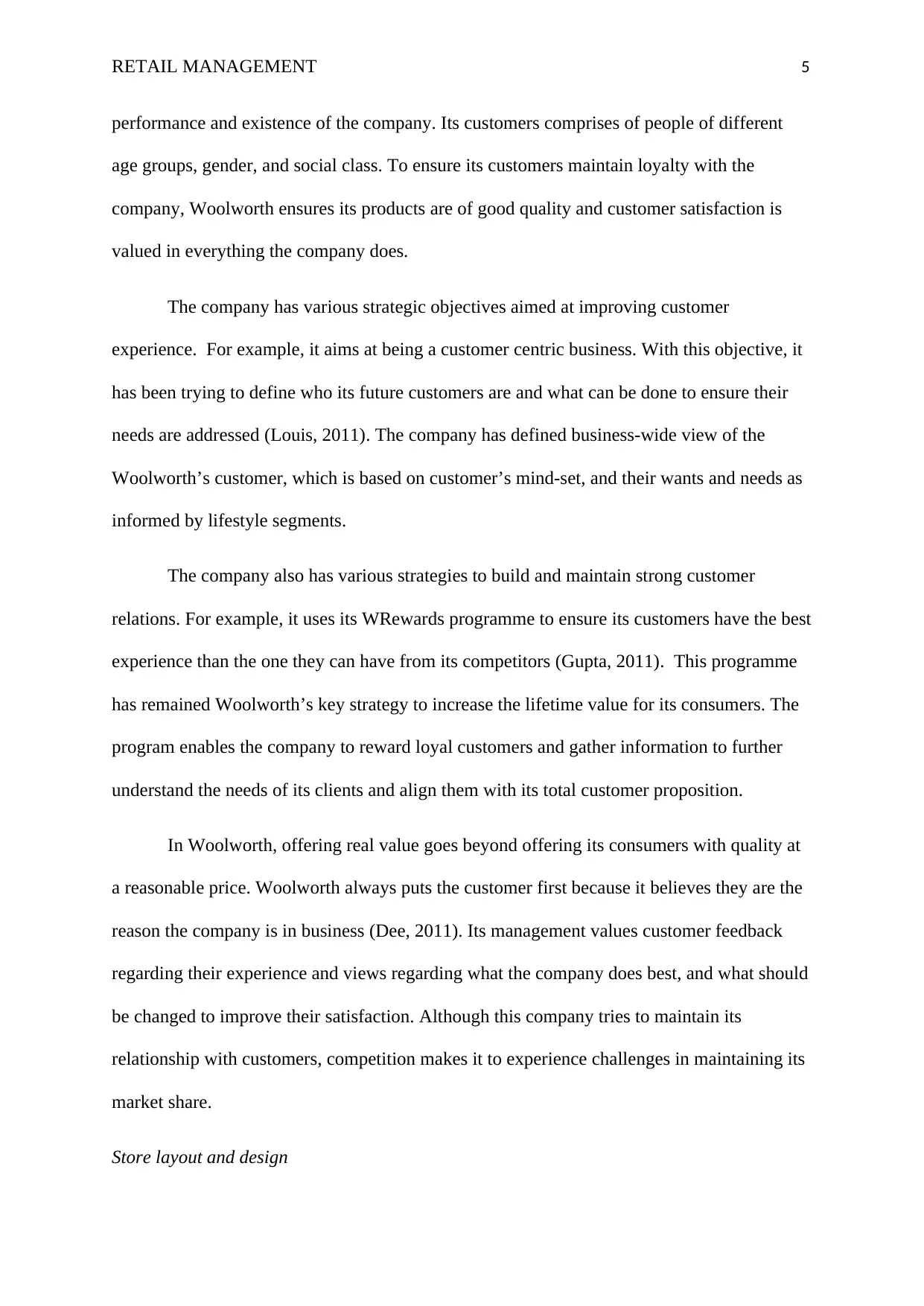
RETAIL MANAGEMENT 5
performance and existence of the company. Its customers comprises of people of different
age groups, gender, and social class. To ensure its customers maintain loyalty with the
company, Woolworth ensures its products are of good quality and customer satisfaction is
valued in everything the company does.
The company has various strategic objectives aimed at improving customer
experience. For example, it aims at being a customer centric business. With this objective, it
has been trying to define who its future customers are and what can be done to ensure their
needs are addressed (Louis, 2011). The company has defined business-wide view of the
Woolworth’s customer, which is based on customer’s mind-set, and their wants and needs as
informed by lifestyle segments.
The company also has various strategies to build and maintain strong customer
relations. For example, it uses its WRewards programme to ensure its customers have the best
experience than the one they can have from its competitors (Gupta, 2011). This programme
has remained Woolworth’s key strategy to increase the lifetime value for its consumers. The
program enables the company to reward loyal customers and gather information to further
understand the needs of its clients and align them with its total customer proposition.
In Woolworth, offering real value goes beyond offering its consumers with quality at
a reasonable price. Woolworth always puts the customer first because it believes they are the
reason the company is in business (Dee, 2011). Its management values customer feedback
regarding their experience and views regarding what the company does best, and what should
be changed to improve their satisfaction. Although this company tries to maintain its
relationship with customers, competition makes it to experience challenges in maintaining its
market share.
Store layout and design
performance and existence of the company. Its customers comprises of people of different
age groups, gender, and social class. To ensure its customers maintain loyalty with the
company, Woolworth ensures its products are of good quality and customer satisfaction is
valued in everything the company does.
The company has various strategic objectives aimed at improving customer
experience. For example, it aims at being a customer centric business. With this objective, it
has been trying to define who its future customers are and what can be done to ensure their
needs are addressed (Louis, 2011). The company has defined business-wide view of the
Woolworth’s customer, which is based on customer’s mind-set, and their wants and needs as
informed by lifestyle segments.
The company also has various strategies to build and maintain strong customer
relations. For example, it uses its WRewards programme to ensure its customers have the best
experience than the one they can have from its competitors (Gupta, 2011). This programme
has remained Woolworth’s key strategy to increase the lifetime value for its consumers. The
program enables the company to reward loyal customers and gather information to further
understand the needs of its clients and align them with its total customer proposition.
In Woolworth, offering real value goes beyond offering its consumers with quality at
a reasonable price. Woolworth always puts the customer first because it believes they are the
reason the company is in business (Dee, 2011). Its management values customer feedback
regarding their experience and views regarding what the company does best, and what should
be changed to improve their satisfaction. Although this company tries to maintain its
relationship with customers, competition makes it to experience challenges in maintaining its
market share.
Store layout and design
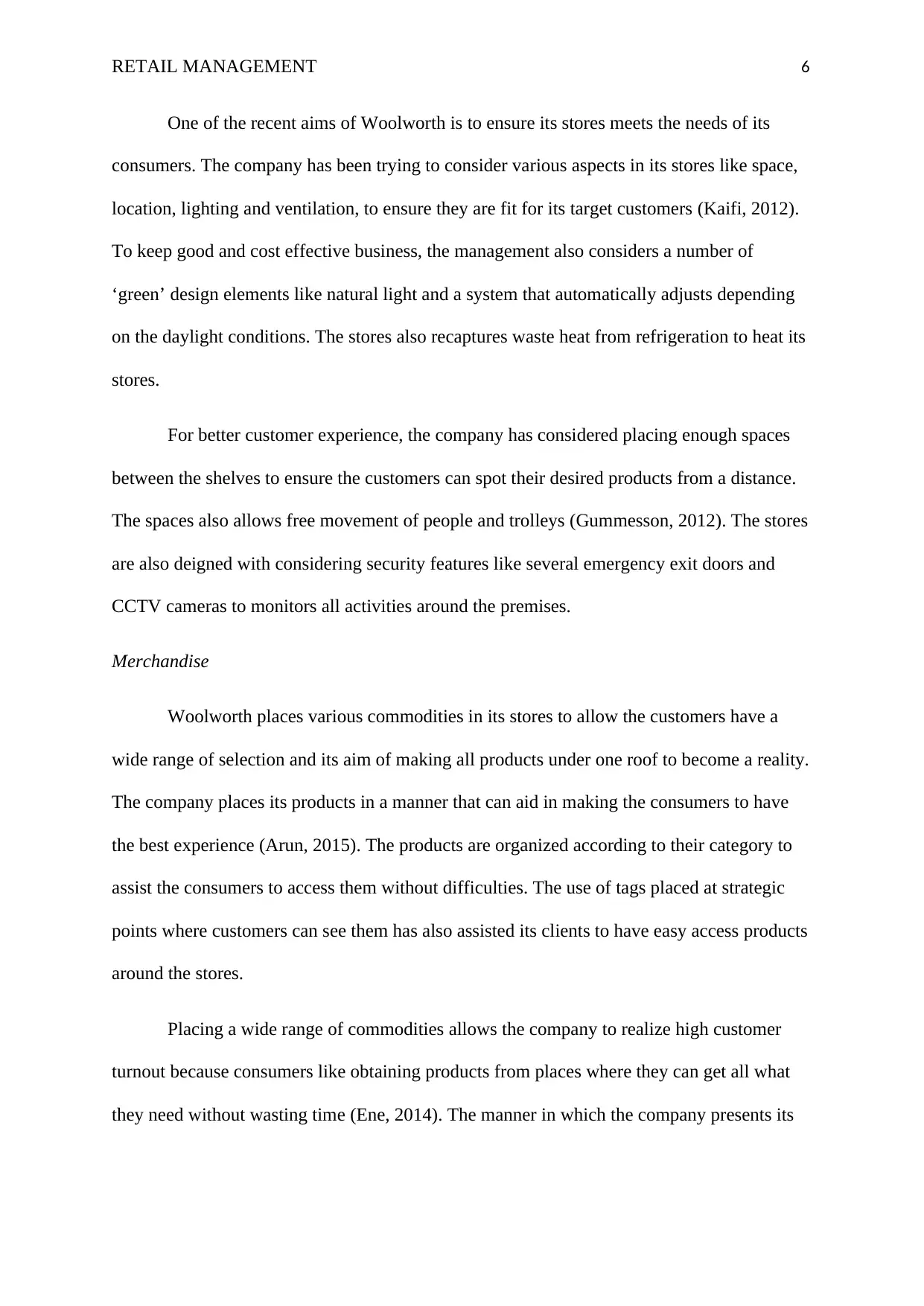
RETAIL MANAGEMENT 6
One of the recent aims of Woolworth is to ensure its stores meets the needs of its
consumers. The company has been trying to consider various aspects in its stores like space,
location, lighting and ventilation, to ensure they are fit for its target customers (Kaifi, 2012).
To keep good and cost effective business, the management also considers a number of
‘green’ design elements like natural light and a system that automatically adjusts depending
on the daylight conditions. The stores also recaptures waste heat from refrigeration to heat its
stores.
For better customer experience, the company has considered placing enough spaces
between the shelves to ensure the customers can spot their desired products from a distance.
The spaces also allows free movement of people and trolleys (Gummesson, 2012). The stores
are also deigned with considering security features like several emergency exit doors and
CCTV cameras to monitors all activities around the premises.
Merchandise
Woolworth places various commodities in its stores to allow the customers have a
wide range of selection and its aim of making all products under one roof to become a reality.
The company places its products in a manner that can aid in making the consumers to have
the best experience (Arun, 2015). The products are organized according to their category to
assist the consumers to access them without difficulties. The use of tags placed at strategic
points where customers can see them has also assisted its clients to have easy access products
around the stores.
Placing a wide range of commodities allows the company to realize high customer
turnout because consumers like obtaining products from places where they can get all what
they need without wasting time (Ene, 2014). The manner in which the company presents its
One of the recent aims of Woolworth is to ensure its stores meets the needs of its
consumers. The company has been trying to consider various aspects in its stores like space,
location, lighting and ventilation, to ensure they are fit for its target customers (Kaifi, 2012).
To keep good and cost effective business, the management also considers a number of
‘green’ design elements like natural light and a system that automatically adjusts depending
on the daylight conditions. The stores also recaptures waste heat from refrigeration to heat its
stores.
For better customer experience, the company has considered placing enough spaces
between the shelves to ensure the customers can spot their desired products from a distance.
The spaces also allows free movement of people and trolleys (Gummesson, 2012). The stores
are also deigned with considering security features like several emergency exit doors and
CCTV cameras to monitors all activities around the premises.
Merchandise
Woolworth places various commodities in its stores to allow the customers have a
wide range of selection and its aim of making all products under one roof to become a reality.
The company places its products in a manner that can aid in making the consumers to have
the best experience (Arun, 2015). The products are organized according to their category to
assist the consumers to access them without difficulties. The use of tags placed at strategic
points where customers can see them has also assisted its clients to have easy access products
around the stores.
Placing a wide range of commodities allows the company to realize high customer
turnout because consumers like obtaining products from places where they can get all what
they need without wasting time (Ene, 2014). The manner in which the company presents its
⊘ This is a preview!⊘
Do you want full access?
Subscribe today to unlock all pages.

Trusted by 1+ million students worldwide
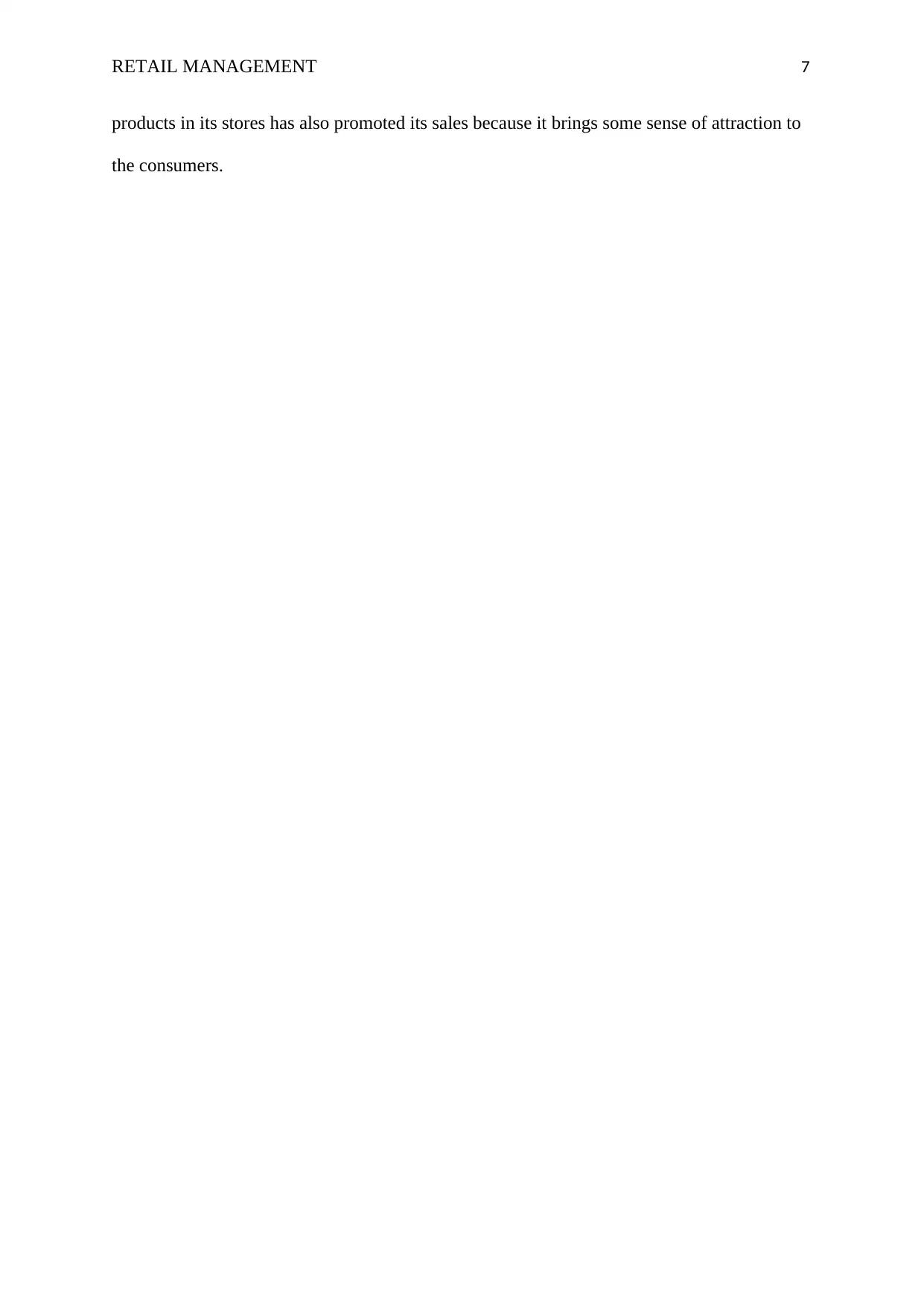
RETAIL MANAGEMENT 7
products in its stores has also promoted its sales because it brings some sense of attraction to
the consumers.
products in its stores has also promoted its sales because it brings some sense of attraction to
the consumers.
Paraphrase This Document
Need a fresh take? Get an instant paraphrase of this document with our AI Paraphraser
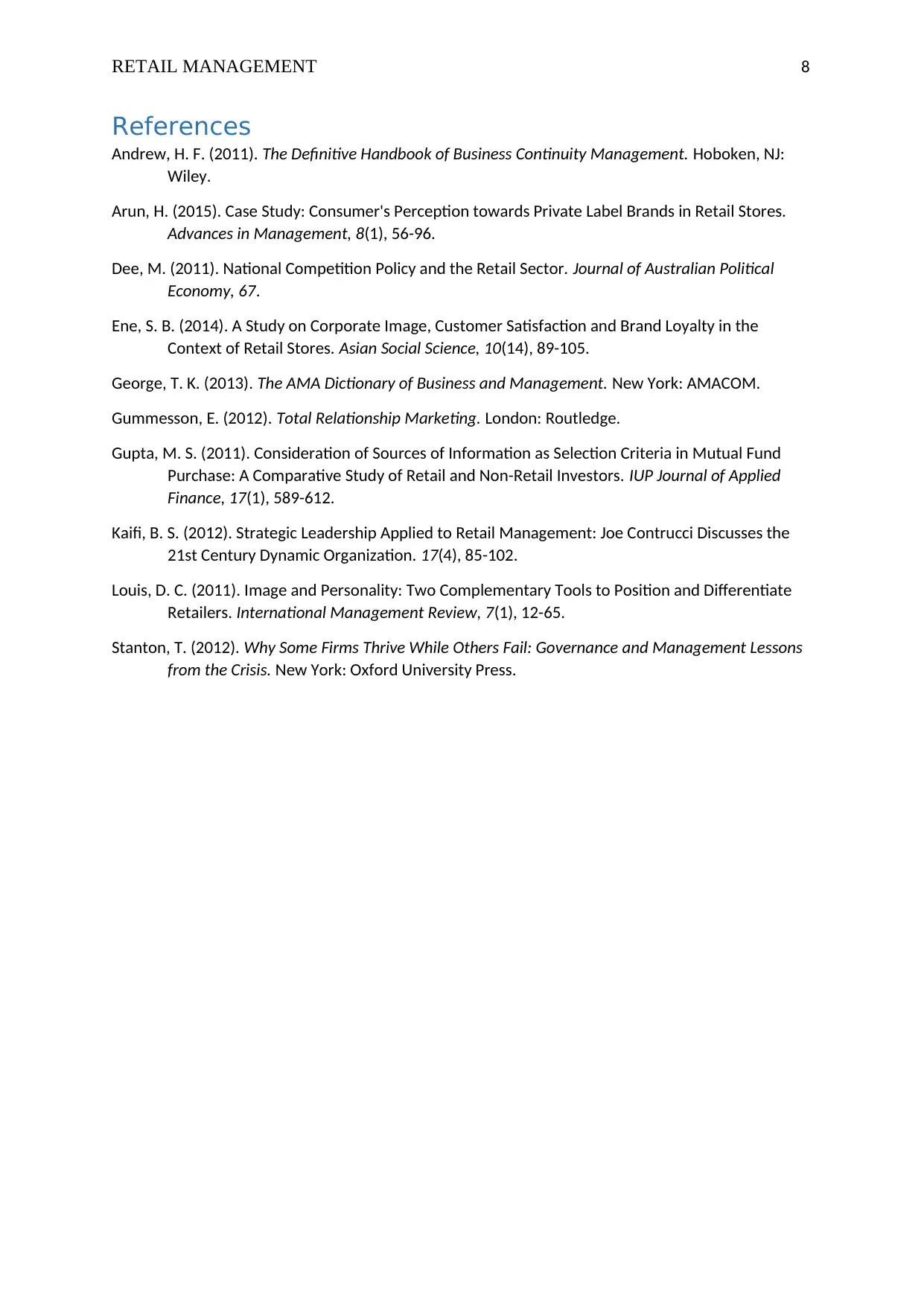
RETAIL MANAGEMENT 8
References
Andrew, H. F. (2011). The Definitive Handbook of Business Continuity Management. Hoboken, NJ:
Wiley.
Arun, H. (2015). Case Study: Consumer's Perception towards Private Label Brands in Retail Stores.
Advances in Management, 8(1), 56-96.
Dee, M. (2011). National Competition Policy and the Retail Sector. Journal of Australian Political
Economy, 67.
Ene, S. B. (2014). A Study on Corporate Image, Customer Satisfaction and Brand Loyalty in the
Context of Retail Stores. Asian Social Science, 10(14), 89-105.
George, T. K. (2013). The AMA Dictionary of Business and Management. New York: AMACOM.
Gummesson, E. (2012). Total Relationship Marketing. London: Routledge.
Gupta, M. S. (2011). Consideration of Sources of Information as Selection Criteria in Mutual Fund
Purchase: A Comparative Study of Retail and Non-Retail Investors. IUP Journal of Applied
Finance, 17(1), 589-612.
Kaifi, B. S. (2012). Strategic Leadership Applied to Retail Management: Joe Contrucci Discusses the
21st Century Dynamic Organization. 17(4), 85-102.
Louis, D. C. (2011). Image and Personality: Two Complementary Tools to Position and Differentiate
Retailers. International Management Review, 7(1), 12-65.
Stanton, T. (2012). Why Some Firms Thrive While Others Fail: Governance and Management Lessons
from the Crisis. New York: Oxford University Press.
References
Andrew, H. F. (2011). The Definitive Handbook of Business Continuity Management. Hoboken, NJ:
Wiley.
Arun, H. (2015). Case Study: Consumer's Perception towards Private Label Brands in Retail Stores.
Advances in Management, 8(1), 56-96.
Dee, M. (2011). National Competition Policy and the Retail Sector. Journal of Australian Political
Economy, 67.
Ene, S. B. (2014). A Study on Corporate Image, Customer Satisfaction and Brand Loyalty in the
Context of Retail Stores. Asian Social Science, 10(14), 89-105.
George, T. K. (2013). The AMA Dictionary of Business and Management. New York: AMACOM.
Gummesson, E. (2012). Total Relationship Marketing. London: Routledge.
Gupta, M. S. (2011). Consideration of Sources of Information as Selection Criteria in Mutual Fund
Purchase: A Comparative Study of Retail and Non-Retail Investors. IUP Journal of Applied
Finance, 17(1), 589-612.
Kaifi, B. S. (2012). Strategic Leadership Applied to Retail Management: Joe Contrucci Discusses the
21st Century Dynamic Organization. 17(4), 85-102.
Louis, D. C. (2011). Image and Personality: Two Complementary Tools to Position and Differentiate
Retailers. International Management Review, 7(1), 12-65.
Stanton, T. (2012). Why Some Firms Thrive While Others Fail: Governance and Management Lessons
from the Crisis. New York: Oxford University Press.
1 out of 8
Related Documents
Your All-in-One AI-Powered Toolkit for Academic Success.
+13062052269
info@desklib.com
Available 24*7 on WhatsApp / Email
![[object Object]](/_next/static/media/star-bottom.7253800d.svg)
Unlock your academic potential
Copyright © 2020–2025 A2Z Services. All Rights Reserved. Developed and managed by ZUCOL.




